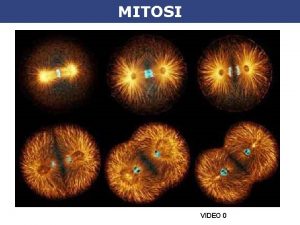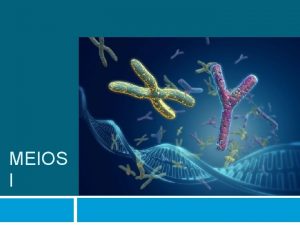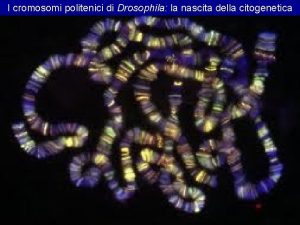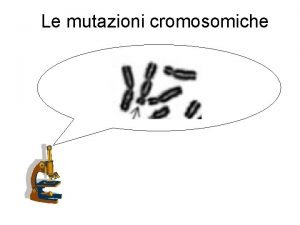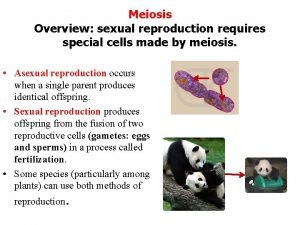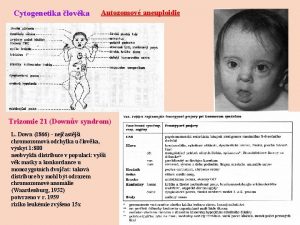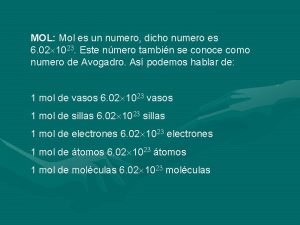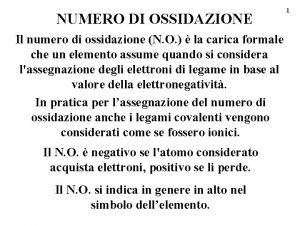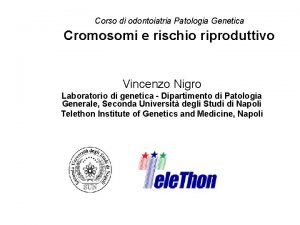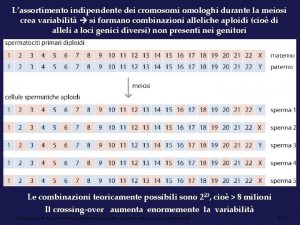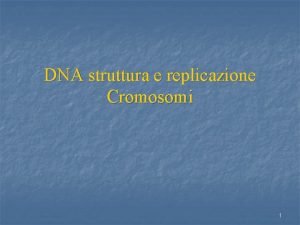ANEUPLOIDIE Variazioni del numero di particolari cromosomi allinterno
























- Slides: 24

ANEUPLOIDIE: Variazioni del numero di particolari cromosomi all’interno di un assetto

Non disgiunzione meiotica: Non disgiunzione meiotica completa: n n n+1 Aneuploidia Poliploidia n-1 n+1 n-1 n n

Diagnosi prenatale



Sindrome di KLINEFELTER: 47, XXY

Sindrome di TURNER: 45, X 0

CORPO DI BARR Cellule umane femminili normali XX, con corpi di Barr (frecce) Cellule umane maschili normali XY, senza corpi di Barr

Sex Determination in Humans • Chromosomal sex is determined at fertilization • Sexual differences begin in the 7 th week • Sex is influenced by genetic and environmental factors • Females (generally XX) do not have a Y chromosome • Males (generally XY) have a Y chromosome

Fig. 7. 10

Sex Differentiation • In early embryo there are two internal duct systems – Wolffian (male) – Müllerian (female) • At 7 weeks, developmental pathways activate different sets of genes • Cause undifferentiated gonads to develop as testes or ovaries • Determine the gonadal sex of embryo

Genes on the Y Chromosome • Cause the indifferent gonad to develop as a testis • Sex determining region is the SRY gene • Other genes on the autosomes play an important role • Once testes develop they secrete two hormones – Testosterone – Müllerian Inhibiting Hormone (MIH)

Females Develop in the Absence of Y • Embryonic gonads develop into an ovaries • Testosterone not produced – Wolffian system degenerates • MIH is not produced – Müllerian duct system develops to form oviduct, uterus and parts of the vagina • Sexual phenotype develops – Hormones are important

I. SRY codes for Testis-Determining Factor • Was the object of an intense search. • SRY gene on the Y chromosome was identified as the gene that codes for TDF: – SRY is translocated to X in rare XX males – SRY is absent from Y in rare XY females • The “home run” experiment by Koopman et al. used transgenic mice.

The Transgenic Sry Experiment: How It Was Done • Reference: Nature 351: 117 (1991) • Nuclei of fertilized XX eggs were injected with Sry gene, then the eggs were transplanted to surrogate mothers. • Sry gene then randomly incorporated into a chromosome and was inherited in subsequent cell divisions. • Animals karyotyped after development to adult.

Genotypically Female Mice Transgenic for SRY are Phenotypically Male XY male XX male

Dosage Compensation • Equalizes the amount of X chromosome products in both sexes • In XX females an inactivated X chromosome forms a Barr body in each cell • XY males do not contain Barr bodies

Lyon Hypothesis • One X chromosome is genetically active in the body cells; the second is inactive and tightly coiled • Either the maternal or paternal chromosome can be inactivated • Inactivation is permanent (reset in germ cells) • Inactivation of second X equalizes the activity of X linked genes in males and females • ROSENSTIEL AWARD - Mary Lyon (+ others) 2007

X Chromosome Inactivation • X chromosome inactivation – In cells of female mammals, either the maternal or paternal X chromosome is randomly condensed (Barr body) and is inactive – Occurs in an early embryonic stage, so that all descendents of that particular cell have the same inactive X chromosome, resulting in “mosaic” gene expression – The situation of only females cats with a calico coat is a result of Barr bodies


Lyon-Hypothesis: X-inactivation A precursor cell to all coat color cells Random inactivation early in dev. **Also in calico cats


Mosaicism Reveals the Random Inactivation of one X chromosome Anhidrotic ectodermal dysplasia in a heterozygous woman Regions where sweat glands are absent.

X Chromosome Inactivation (a) Note red Barr bodies in these 4 XX cells. (b) Two XY cell nuclei. (c) Dark patches are due to active pigment mutation of X chromosomes in skin cells.
 Flusso generato dalla gestione reddituale cos'è
Flusso generato dalla gestione reddituale cos'è Rendiconto finanziario schema
Rendiconto finanziario schema Sconfinamento fido segnalazione
Sconfinamento fido segnalazione Proprieta delle proporzioni
Proprieta delle proporzioni Casi particolari parabola
Casi particolari parabola Non si pubblicano particolari scabrosi
Non si pubblicano particolari scabrosi Schema calcolo rai
Schema calcolo rai Il grado di un monomio
Il grado di un monomio Verbi irregolari imperativo
Verbi irregolari imperativo Frazioni particolari
Frazioni particolari Superlativi irregolari latino
Superlativi irregolari latino Piatti particolari
Piatti particolari Tavole trigonometriche
Tavole trigonometriche Present simple variazioni ortografiche
Present simple variazioni ortografiche Variazioni finanziarie positive e negative
Variazioni finanziarie positive e negative Insieme di cromosomi
Insieme di cromosomi Insieme di cromosomi
Insieme di cromosomi Cromosomi politenici
Cromosomi politenici Cromosomi giganti
Cromosomi giganti Allopoliploidia
Allopoliploidia Meiosi
Meiosi Cromosomi omologhi
Cromosomi omologhi Complesso sinaptinemale
Complesso sinaptinemale Cromosomi
Cromosomi Gruppi sanguigni genetica
Gruppi sanguigni genetica















